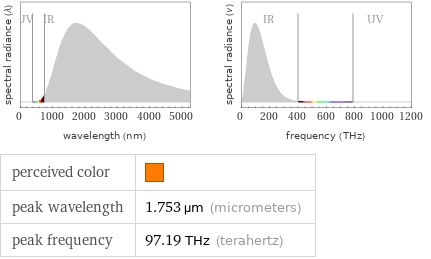Input interpretation

europium(II) fluoride | melting point
Result

1380 °C (degrees Celsius)
Unit conversions

1653 K (kelvins)

2516 °F (degrees Fahrenheit)

2976 °R (degrees Rankine)

1104 °Ré (degrees Réaumur)

732 °Rø (degrees Rømer)
Comparisons as temperature

216.8 °C below temperature of a Bunsen burner flame (1870 K)

158 °C below melting point of iron (1538 °C)

16.85 °C below temperature in the blue part of a candle flame (1670 K)
Blackbody information

perceived color | peak wavelength | 1.753 µm (micrometers) peak frequency | 97.19 THz (terahertz)
Corresponding quantities

Thermodynamic energy E from E = kT: | 14 ceV (centielectronvolts)

Blackbody energy flux Φ from Φ = σT^4: | 423507 W/m^2 (watts per square meter)

Approximate luminous exitance from a planar blackbody radiator perpendicular to its surface: | 109804 lx (lux)